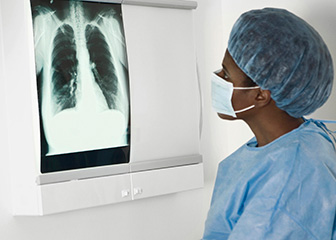
Physicians often work closely with other healthcare staff including physician assistants, registered nurses, and medical records and health information technicians.
Physicians and surgeons diagnose and treat injuries or illnesses. Physicians examine patients, take medical histories, prescribe medications, and order, perform, and interpret diagnostic tests. They often counsel patients on diet, hygiene, and preventive health care. Surgeons operate on patients to treat injuries, such as broken bones; diseases, such as cancerous tumors; and deformities, such as cleft palates.
There are two types of physicians: M.D. (Medical Doctor) and D.O. (Doctor of Osteopathic Medicine). Both types of physicians use the same methods of treatment, including drugs and surgery, but D.O.s place additional emphasis on the body's musculoskeletal system, preventive medicine, and holistic (whole person) patient care.
Duties
Physicians and surgeons typically do the following:
- Take a patient’s medical history
- Update charts and patient information to show current findings
- Order tests for nurses or other healthcare staff to do
- Review test results to identify any abnormal findings
- Recommend and design a plan of treatment
- Answer concerns or questions that patients have about their health and well-being
- Help patients take care of their health by discussing topics such as proper nutrition and hygiene
In addition, surgeons operate on patients to treat injuries, diseases, or deformities.
Physicians and surgeons work in one or more of several specialties. The following are some of the many types of physicians and surgeons:
Anesthesiologists focus on the care of surgical patients and pain relief. They administer the drugs (anesthetics) that reduce or eliminate the sensation of pain during an operation or other medical procedure. During surgery, they are responsible for adjusting the amount of anesthetic as needed and monitoring the patient's heart rate, body temperature, blood pressure, and breathing. They also work outside of the operating room, providing pain relief in the intensive care unit, during labor and delivery, and for those who suffer from chronic pain. Anesthesiologists work with other physicians and surgeons to decide on treatments and procedures before, during, and after surgery.
Family and general physicians assess and treat a range of conditions that occur in everyday life. These conditions include anything from sinus and respiratory infections to broken bones. Family and general physicians typically have a base of regular, long-term patients. These doctors sometimes refer patients with more serious conditions to specialists or other healthcare facilities for additional care.
General internists diagnose and provide nonsurgical treatment for a range of problems that affect internal organ systems such as the stomach, kidneys, liver, and digestive tract. Internists use a variety of diagnostic techniques to treat patients through medication or hospitalization. They may refer patients to other specialists when more complex care is required. They work mostly with adult patients.
General pediatricians provide care for infants, children, teenagers, and young adults. They specialize in diagnosing and treating problems specific to younger people. Most pediatricians treat day-to-day illnesses, minor injuries, and infectious diseases and administer vaccinations. Some pediatricians specialize in pediatric surgery or serious medical conditions that commonly affect younger patients, such as autoimmune disorders or serious chronic ailments.
Obstetricians and gynecologists (OB/GYNs) provide care related to pregnancy and the female reproductive system. OB/GYNs specialize in childbirth. They treat and counsel women throughout their pregnancy, and they deliver babies. They also diagnose and treat health issues specific to women, such as breast cancer, cervical cancer, hormonal disorders, and symptoms related to menopause.
Psychiatrists are primary mental health physicians. They diagnose and treat mental illnesses through a combination of personal counseling (psychotherapy), psychoanalysis, hospitalization, and medication. Psychotherapy involves regular discussions with patients about their problems. The psychiatrist helps them find solutions through changes in their behavioral patterns, exploring their past experiences, or group and family therapy sessions. Psychoanalysis involves long-term psychotherapy and counseling for patients. Psychiatrists may prescribe medications to correct chemical imbalances that cause some mental illnesses.
Surgeons specialize in treating injury, disease, and deformity through operations. Using a variety of instruments, and with patients under anesthesia, a surgeon corrects physical deformities, repairs bone and tissue after injuries, or performs preventive surgeries on patients. Although a large number perform general surgery, many surgeons choose to specialize in a specific area. Specialties include orthopedic surgery (the treatment of the musculoskeletal system), neurological surgery (treatment of the brain and nervous system), cardiovascular surgery, and plastic or reconstructive surgery. Like other physicians, surgeons also examine patients, perform and interpret diagnostic tests, and counsel patients on preventive healthcare. Some specialist physicians also perform surgery.
D.O.s are most likely to be primary care physicians, although they can be found in all specialties. About 60 percent of D.O.s specialize in primary care areas such as family medicine, internal medicine, OB/GYN, and pediatrics.
Among physicians and surgeons who work in a number of other medical and surgical specialists and subspecialties are allergists (specialists in diagnosing and treating hay fever and other allergies), cardiologists (heart specialists), dermatologists (skin specialists), gastroenterologists, (specialists in the digestive system), pathologists (who study body tissue to see if it is normal), radiologists (who review and interpret x-ray pictures and deliver radiation treatments for cancer and other illnesses), and many others.
Physicians work daily with other healthcare staff, such as nurses, other physicians, and medical assistants. For more information, see the profiles on registered nurses and medical assistants.











